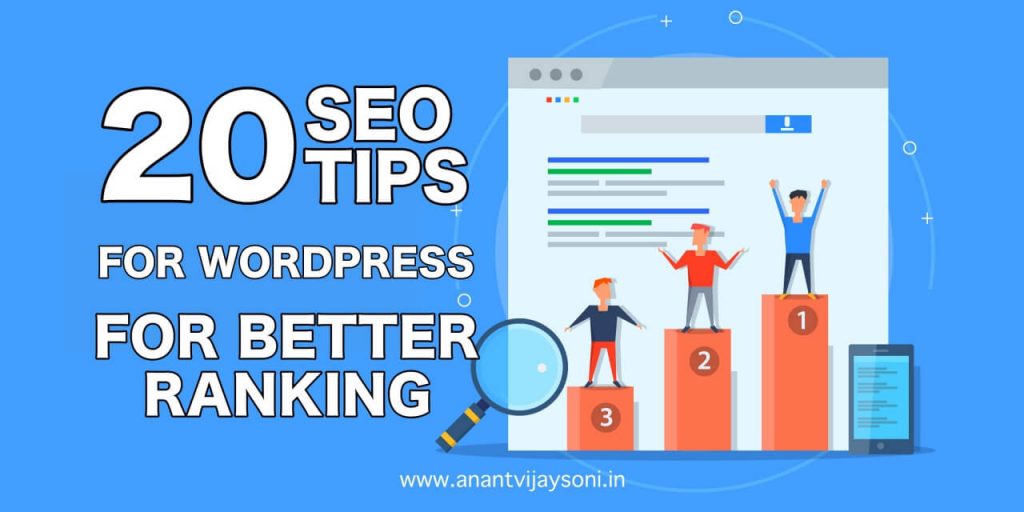Do you want to know my Favorite SEO Tips for WordPress to rank higher in search engines?
I have compiled 20 of my best SEO tips for WordPress, which I am using on my own blog Anantvijaysoni.in, not only to rank higher, but also to stay immune from Google Panda, Penguin and all sorts of SE algorithm changes.
SEO is an Art + Science of fine-tuning of your contents and your WordPress blog as a whole to be loved by your readers and Search Engines to rank higher.
As such Google likes WordPress as a CMS (Content Management System) and always gives priority to its contents on SERPs, admitted by Matt Cutts, The Head of Google Web-Spam Team.
So, these 20 SEO Tips for WordPress are like a cherry on ice for an already search engine tuned blogging platform.
Table of Contents
20 SEO Tips for WordPress to Turbocharge Your Blog
1. Clean Your Theme Header
Your first and foremost SEO effort should be to make your WordPress theme SEO friendly. For this, you have to keep your theme header clean.
Multiple images and flash elements in header area not only results in delayed indexing (blog posts) by search engine spider but also end-up with lower ranking on SERPs.
An ideal SEO friendly WordPress theme header should contain a logo only. You can put a Search Box also, but that’s all. Not more than that. This is one of my best SEO tips for every WordPress user. Let the SE bots enter your blog freely, let them roam around and audit your contents. By putting unnecessary junk in the header, you are simply making your blog out-of-bounds for search engine bots.
2. Make Your Permalink Pretty
You must be aware of Pretty URL and Dirty URL. By default, WordPress produces a dirty URL, every time you publish a post.
Example of Dirty URL – https://www.anantvijaysoni.in/index.php?page8725=start=access=4&category=33
Example of Pretty URL – https://www.anantvijaysoni.in/wordpress/20-seo-tips-for-wordpress-for-better-ranking
By setting your permalink structure, you can make your URLs pretty, every time you publish a post. These URLs are not only easy to remember but also search engine friendly.
The best permalink structures for SEO purpose are /%category%/%postname%/ and /%postname%.
How to do: Login to your WordPress dashboard –> Setting –>Permalinks –> Enter a custom structure by checking the radio button –> Click on Save Changes.
3. Use Keywords In Your Title
More than 80% of bloggers don’t give much importance to the ‘article heading.’
They either write a heading to please the Google with proper Search Engine Optimization, or they try to amuse their daddy dear by writing a 100% witty heading. Is there any way to accomplish both the goals? Of course, it’s there!
Google ranks an article higher, if the title contains the keyword, especially at the beginning. This is a universally accepted SEO technique by SEO practitioners all over the world.
But you shouldn’t use your keyword more than once, and your title should flow naturally with your keywords. I mean, you should write article heading to please Google as well as your readers.
Example: 20 SEO Tips for WordPress for Better Ranking, is my title for this article.
My keyword phrase for this article is “SEO Tips for WordPress.” And, I have placed my target keyword at the beginning of the title.
4. Use Breadcrumb
Search engines love breadcrumb, and your readers also. Google integrates breadcrumb navigation within the SERPs, making your post more attractive and trustworthy.
It gives better user experience to your visitors by providing a solid navigational system, in addition to the SEO benefits.
Download one of the popular WordPress plugin called Breadcrumb NavXT here.
5. Unique Content
Do you like amazing content? Search engines too!
This is most probably the best SEO tips for WordPress in the current time and the time to come. Don’t be disheartened or angry with me. It’s a fact! And, we should face it bravely!!
Tell me – Who doesn’t like to read a well researched, informative and high quality article? Search engines rank an article based on its quality, uniqueness, and freshness.
6. Proper Keyword Density
Keywords are like manures. Use it properly and reap the rich rewards! Do the opposite and be ready to be kicked by the Penguin!!
You should sprinkle your keywords naturally on your article. Search engines always give priority to user satisfaction, not your SEO efforts. By repeating your keywords 20 times instead of 5 will not rank you higher. Instead, you may be penalized for keyword stuffing.
The optimum keyword density in your blog post or page should be 1 to 2%.
7. Image Optimization
Image optimization plays a great role in higher ranking of your blog posts. You must be aware that search engines are image blind.
Use keyword rich ALT tag and file name to augment your post. I get lots of traffic from Google image search everyday. This is only possible due to proper image optimization.
Make sure, the content surrounding the image describes it adequately to get better SEO benefits.
8. Internal Linking
Inter-link your articles with proper anchor texts. Search engines like inter-linking of articles because it provides better information and user satisfaction.
In addition to SEO benefit, inter-linking increases page views and improves the bounce rate of your WordPress blog.
9. Outbound Links
Never hesitate to link external sites for reference or better information or to accomplish a specific task. Search engines trust sites who link other websites for better user experience.
When you link other sites in your blog posts, your users also trust you because “ You are more concern about your users than your personal gain ”.
But don’t link external websites unnecessarily for the sake of SEO only.
10. Canonicalization
Canonicalization means redirecting multiple URLs to a single dominant version. Search engines see multiple URLs as a duplicate content.
You have to make sure the www version of your blog( http://www.YourDomainName.com) 301- redirects to the non-www version (http://YourDomainname.com), or vice versa. This is also called a canonical redirect.
Use this WordPress plugin called Canonical link to perform this task.
11. Optimize Your Comments
Do you know – Every comment on your blog or post counted as a fresh content by search engines?
The very first time when I received a visitor searching for a term on my post comment, I surprised. Later on, it became a daily affair. I get so many visitors with search terms or keywords on my comment system.
Comment optimization is an art and you have to acquire it for the long term benefit of your blogging career.
You should respond to all your comments or commenters. By doing this you are not only adding fresh content to your blog but also leading the discussion to a higher level for more comments.
Never forget to use your keywords judiciously while answering the comments.
12. Leverage Social Media
Social signal plays a vital role in SEO. Google has confirmed this with the introduction of Google+ in search results.
Use at least 4 to 5 social networking sites like Facebook, Google+, Twitter, StumbleUpon and Digg to promote your blog. When people like your blog post on Facebook or Google+, search engines promote it on SERPs.
If the like or G+ is from a famous personality or a major influencer in the social media world, search engines promote your blog post even higher.
13. Use Google XML Sitemap
From an SEO point of view, A sitemap is a must for every WordPress blog.
Sitemap informs search engines to index your newly published blog post and subsequent ranking on SERPs. Search engines also like a blog with a sitemap.
Use Google XML sitemap WordPress plugin to make a sitemap for your blog.
14. Use a CDN (Content Delivery Network)
CDN helps your blog pages load faster by distributing the static content (JavaScript, Images, Videos, CSS) from servers located in different parts of the world.
Google likes fast loading pages or sites, and also included in it’s ranking algorithm. Use the best CDN WordPress plugins WP Super Cache and W3 Total Cache to make your blog faster.
15. Clean Your Above The Folds
The visible part of the website from the top, on the user’s computer, is called ‘ above the fold.’ This is the portion (site or blog), which your users first see when they arrive on your blog.
Above the fold, the area should be content rich. It should not be cluttered with a bag full of AdSense Ads, affiliate Ads or likes. Google demotes sites showing less content and more Ads above the fold.
Unfortunately, lots of bloggers have contents wedged between cheap AdSense Ads, specially above the fold. An Ad between the article is a definite turn-off for every reader. Make your above the fold content-rich for higher ranking in SERPs.
16. Don’t Use Sponsored Themes
Google don’t like sponsored themes and recently penalized lots of websites and blogs for using this.
The sponsored theme looks great, and moreover, they are free. Due to this reason bloggers love to use sponsored themes for their blogging needs. Even lots of small and medium sized online business sites also use sponsored themes.
On these types of themes, you will find links like Sponsored by…. or Designed by……usually on the footer area. Actually, these links are created by companies to rank better in search engines. Instead of putting Ads on different websites, they prefer to sponsor themes by putting a hyperlink on the footer, which subsequently downloaded and used by thousands of blog and website owners.
You should either refrain from sponsored themes or if possible remove the footer credit (sponsored hyperlink).
17. Avoid Duplicate Contents
Search engines hate duplicate contents, just like you and me.
Do you know – When you publish a blog post, all the URLs from the category, sub-category, tags or archives mirror each other and act like duplicate content.
To SEO your WordPress blog, you have to avoid this duplicate content issue by adding Disallow directive in a robots.txt file.
robots.txt is a simple text file located at the root of your WordPress blog. By adding a disallow directive you are telling the search engines crawlers not to index some pages or directories. Copy and paste the following codes in your robots.txt file to no-index your tags and archives-
User-agent: * Disallow: /tags/$ Disallow: /archives/$
18. Pinging 3rd Party Services
Have you pinged your WordPress blog? If not, then you should ping your blog posts for more traffic from search engine.
Pinging means you are informing a website that you have updated your blog. You have to ping correctly and adequately to SEO for WordPress.
How to Ping Your WordPress Blog for Better Search Engine Traffic. Login to your WordPress dashboard –> Setting –> Writing. Then scroll down to the bottom of the page. Under Update Services a text area for you to specify the URL you would like to ping.
I personally consider the below mentioned web site is the best for pinging for WordPress SEO. Simply copy and paste the below code in the text area for URLs :
http://rpc.pingomatic.com http://rpc.twingly.com http://api.feedster.com/ping http://api.moreover.com/RPC2 http://api.moreover.com/ping http://www.blogdigger.com/RPC2 http://www.blogshares.com/rpc.php http://www.blogsnow.com/ping http://www.blogstreet.com/xrbin/xmlrpc.cgi http://bulkfeeds.net/rpc http://www.newsisfree.com/xmlrpctest.php http://ping.blo.gs/ http://ping.feedburner.com http://ping.syndic8.com/xmlrpc.php http://ping.weblogalot.com/rpc.php http://rpc.blogrolling.com/pinger/ http://rpc.technorati.com/rpc/ping http://rpc.weblogs.com/RPC2 http://www.feedsubmitter.com http://blo.gs/ping.php http://www.pingerati.net http://www.pingmyblog.com http://geourl.org/ping http://ipings.com http://www.weblogalot.com/ping
19. Use WordPress SEO Plugin
The most common mistake newbie WordPress bloggers do is – They simply forget everything after installing the Yoast SEO or All-in-One SEO Pack and expect it will do a miracle!
You have to spend a few minutes (2 to 3 mins.) with this plugin, every time you publish a post to get an optimum result. By using this plugin you can control the title, meta description and meta tags for each post and pages easily.
Yoast SEO is my all-time favorite SEO WordPress Plugin, and I am using it on Anantvijaysoni.in, the blog which you are enjoying now.
20. Use Google Webmaster Tools
Time and again, Google and Bing are telling webmasters to use their tools to improve their search ranking and traffic. You should Sign-Up for Google Webmaster Tools and Bing Webmaster Tools for better SEO and traffic.
If you are not getting regular visitors from Bing or Yahoo, then most probably you are not using Bing webmaster tools.
Just now I have told you my favorite 20 SEO Tips for WordPress. But I am not tired, I can keep on telling you few more…. Continue reading – If you really are an SEO jockey riding high on WordPress!
3 Extra SEO Tips for WordPress
(a) Compelling Meta Description
Do you write beautiful meta description to attract web surfers?
Actually, the meta description has nothing to do with SEO. But crafting a compelling meta description surely attracts tons of visitors to your WordPress blog.
It appears just below your post title on SERP with highlighted search terms. Always ensure to add your keywords in the meta description in a natural manner.
(b) Related Posts
Again a great way to offer a few more related articles to your readers. It helps to increase page views and improve your bounce rate. Download the WordPress Related Posts plugin here.
(c) Valid XHTML Code
Great bloggers always feel proud of using clean and valid XHTML code on their WordPress blog.
Although your search ranking doesn’t affect by minor invalid XHTML code, it is still advisable to use a correct one.
Validate your website here and follow the simple instructions to correct it.
20 SEO Tips for WordPress for Better Ranking – This post was created keeping in mind all the latest SEO techniques and trends, and Google’s Webmaster Guidelines. If you have a point or two or having some doubts, please mention below in the comments. I will be right here to address all.






6 Comments
very nice content. Keep going guys
HEY there! I must say you have written about this topic very precisely.
Good! Such a great information.
I’m Happy to learn from this blog.
Great information! Helps a lot.
Very valuable information. I’m Happy to learn from this blog.
thanks for sharing with us
Hi Anant,
I am a subscriber to your YouTube channel for quite a while. Appreciate your regular education videos. Can you please suggest me a WordPress plugin for internal linking. I think the internal linking should come naturally and a plugin can help in this
Thanks